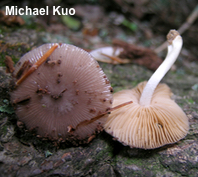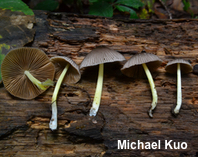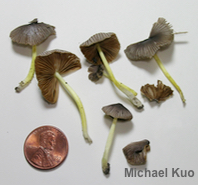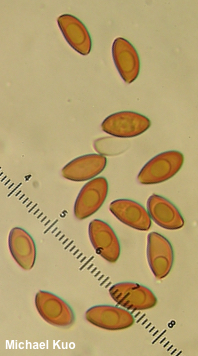| Major Groups > Gilled Mushrooms > Dark-Spored > Wood-Rotting LBMs > Bolbitius Bolbitius reticulatus |

|
[ Basidiomycota > Agaricales > Bolbitiaceae > Bolbitius . . . ] Bolbitius reticulatus by Michael Kuo, 30 October 2023 Bolbitius reticulatus grows on wood or woody debris—including woodchips—in Europe and North America. Its cap is sticky, fragile, and deeply lined, and its spore print is cinnamon brown. Some forms are pale grayish, and are reminiscent of the dry-capped, pink-spored Pluteus longistriatus. Other forms are purple or lilac—and intermediate forms are collected with some frequency. To add to the confusion, both grayish and purple-brown forms sometimes develop a prominently veined-reticulate cap surface (hence the species epithet reticulatus). To reflect these substantial differences in features, varieties of Bolbitius reticulatus have been named over the years, including aleuriatus and pluteoides (sometimes these taxa are elevated to species rank), but recent DNA-based research supports using "a wide species concept for B. reticulatus, without subdividing it into traditionally accepted varieties and forms" (Malysheva et al. 2015, 12). Description: Ecology: Saprobic, decomposing the deadwood of hardwoods—decaying logs in woodland settings, and woodchips in urban settings; growing alone or scattered; summer and fall (and over winter in warm climates); originally described from Europe (Persoon 1789); widespread in Europe and in North America. The illustrated and described collections are from Illinois and Missouri. Cap: 1–3 cm; convex to broadly conic, becoming broadly bell-shaped to broadly convex and eventually nearly flat; fragile; gray to purple-gray or purple at first, becoming grayish tan to gray or lilac gray, often with a darker center; sticky when fresh; bald; strongly lined, often nearly all the way to the center. Gills: Free from the stem or very narrowly attached to it; close; short-gills frequent; whitish at first, becoming faintly pinkish to brownish, then cinnamon brown. Stem: 2.5–4 cm long; 1–3 mm thick; equal; fragile; hollowing; finely scaly to powdery, or more or less bald; white to yellowish or yellow. Flesh: Insubstantial; whitish; unchanging when sliced. Odor: Not distinctive. Chemical Reactions: KOH on cap surface negative. Spore Print: Dull cinnamon brown. Microscopic Features: Spores 9–11 x 4.5–5.5 µm; amygdaliform to subellipsoid, with a small pore; smooth; thick-walled; brown in KOH. Basidia abruptly clavate; 4-sterigmate. Brachybasidioles present. Cheilocystidia irregularly cylindric or subclavate; smooth; thin-walled; hyaline in KOH. Pleurocystidia not found. Pileipellis hymeniform; terminal cells clavate, obpyriform, or saccate; smooth; hyaline to brown in KOH. REFERENCES: (C. H. Persoon, 1798) A. Ricken, 1915. (Fries, 1821; Kauffman, 1918; Phillips, 1981; Watling, 1982; Arora, 1986; Schalkwijk-Barendsen, 1991; Hansen & Knudsen, 1992; Arnolds, 2005; McNeil, 2006; Miller & Miller, 2006; Buczacki et al., 2013; Kuo & Methven, 2014; Desjardin, Wood & Stevens, 2015; Malysheva et al., 2015; Siegel & Schwarz, 2016; Gminder & Böhning, 2017; Hausknecht & Vesterholt, 2018; Læssøe & Petersen, 2019; Kaygusuz, 2022.) Herb. Kuo 09121401. This site contains no information about the edibility or toxicity of mushrooms. |
© MushroomExpert.Com |
|
Cite this page as: Kuo, M. (2023, October). Bolbitius reticulatus. Retrieved from the MushroomExpert.Com Web site: http://www.mushroomexpert.com/bolbitius_reticulatus.html |



